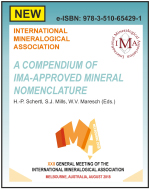Home page > About IMA > Mission
Mission
Mineralogy is one of the oldest branches of Science. In classical terms it is the study of the formation, the properties and the uses of minerals. Minerals are the inorganic building blocks of rocks and are characterized by a particular chemical compositions and a defined crystal structure. Historically, mineralogy was primarily descriptive and concentrated on material found in nature, but in modern terms mineralogy is best viewed as that branch of the Earth sciences that in methodology and outlook is closely related to materials science. Therefore, mineralogy can be seen as a link between the Earth sciences on the one hand and physics, chemistry and applied materials engineering on the other.
The term mineral sciences is often used to reflect a more modern broadened scope, and it is now customary to use it to summarize together classical fields such as crystallography, petrology, petrography, geochemistry, cosmochemistry, descriptive mineralogy, gemmology, clay mineralogy, applied and technical mineralogy, ore mineralogy and economic geology, environmental mineralogy, archaeometry, etc.. However, the boundaries between these disciplines have become blurred; definitions and usage may vary from language to language.
Mineralogy today plays a vital role in human welfare. Mineralogical methodology is necessary for finding, exploiting and recycling strategic and dwindling natural resources. Many minerals provide key templates for engineering new materials and improving industrial processes. Mineralogy is a key player in finding solutions to problems of waste disposal and the remediation of pollution. Near Earth’s surface, minerals of the solid Earth interact with the atmosphere and the biosphere. These processes are crucial to our understanding of climate and global change. They are also crucial to human health. In the deep Earth, mineralogy is fundamental to our knowledge of the chemistry, mode of formation and age of rocks, helping us to understand the geodynamics of our planet and its role in cycling chemical components between surface and interior. The behaviour of volcanoes, geothermal systems, and shale gas reservoirs all depend on their minerals. The study of extraterrestrial materials gives us clues to the origin of the Solar System and the likelihood of life on other planets. Most people know the beautiful and valuable gem forms of minerals.
As stated in Article 2 of the IMA statutes, the objectives of the Association are to further international cooperation in the mineralogical sciences. At present societies and/or organizations from 38 countries have joined together to constitute the IMA. The International Mineralogical Association organizes commissions, working groups and committees in specific fields to bring together experts from all over the world to foster and coordinate research in classical as well as emerging fields. One of its most important and also most difficult tasks is to oversee mineral nomenclature and classification. The IMA also stresses the importance of preserving mineral collections and making mineral descriptions and scientific data available in a systematic way.
The International Mineralogical Association seeks to promote discourse and to disseminate information via its commissions, working groups and committees, which are actively involved in scientific meetings throughout the world. Every four years one of its member societies organizes an IMA General Meeting to bring together scientists from all over the world.
The International Mineralogical Association bestows an IMA Medal for Excellence in Mineralogical Research, which is awarded for scientific excellence and eminence, as represented by long-term outstanding scientific publication in the field of mineralogical sciences. It is to be considered as one of the pre-eminent awards in mineralogical research, and represents a life-time achievement award.



